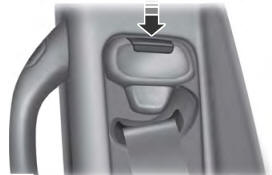Ford Explorer: Parking Aid - Vehicles With: Rear Parking Aid / General Procedures - Azimuth System Check
Check
-
NOTE: The object used in this system check can be fabricated using a 9 cm diameter (3 in I.D.) pipe, 100 cm (39 in) in length (available as Polyvinyl Chloride (PVC) pipe, or similar from a hardware or plumbing supply.
NOTE: The following system check should be carried out with the vehicle on a level surface.
NOTE: Actual sensor arrangement may differ from the configuration shown.
Distribute the test objects evenly across the bumper as shown. Refer to the specifications in this section.
.jpg) |
-
Turn the ignition switch to the ON position, engine off.
-
Apply the parking brake.
-
Select REVERSE (R) for rear parking aid.
-
Select DRIVE (D) for front parking aid.
-
NOTE: The system provides audio warnings only when the vehicle is moving or when the vehicle is stationary and the detected obstacle is less than 12 in (30 cm) away from the bumper.
Using a diagnostic scan tool, monitor the parking aid sensor distance Parameter Identifications (PIDs) to verify the objects are detected when placed in the specified locations (P1, P2, P3, P4 and P5).
 Diagnosis and Testing - Parking Aid
Diagnosis and Testing - Parking Aid
Diagnostic Trouble Code (DTC) Chart
Diagnostics in this manual assume a certain skill level and knowledge of Ford-specific diagnostic practices. REFER to: Diagnostic Methods (100-00 General Informati..
 General Procedures - Elevation System Check
General Procedures - Elevation System Check
Check
Turn the ignition ON, engine OFF.
Set the parking brake.
Place the gearshift in REVERSE (R) for rear parking aid sensors...
Other information:
Ford Explorer 2020-2025 Owners Manual: Vehicle Identification Number & Vehicle Certification Label
Vehicle Identification Number The vehicle identification number is on the left-hand side of the instrument panel. Please note that in the graphic, XXXX is representative of your vehicle identification number. The Vehicle Identification Number contains the following information: A - World manufacturer identifier...
Ford Explorer 2020-2025 Owners Manual: Checking the Wiper Blades & Changing the Front Wiper Blades
Run the tip of your fingers over the edge of the blade to check for roughness. Clean the wiper blades with washer fluid or water applied with a soft sponge or cloth. Changing the Front Wiper Blades You can improve poor wiper quality by cleaning the wiper blades and the windshield...
Categories
- Manuals Home
- 6th Generation Explorer Owners Manual
- 6th Generation Explorer Service Manual
- Body and Paint
- Body and Paint
- Removal and Installation - All-Wheel Drive (AWD) Module
- New on site
- Most important about car
Seatbelt Height Adjustment
WARNING: Position the seatbelt height adjuster so that the seatbelt rests across the middle of your shoulder. Failure to adjust the seatbelt correctly could reduce its effectiveness and increase the risk of injury in a crash.

